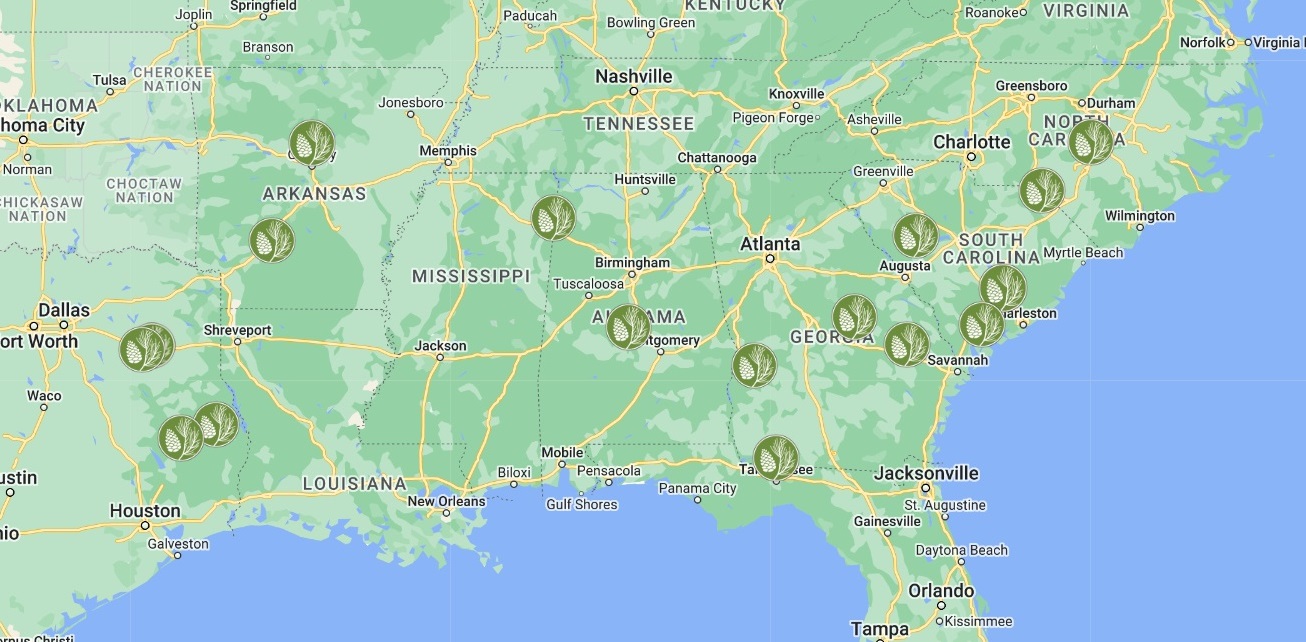This question is one of the most commonly asked by landowners to Reforestation Advisors. Dozens of articles and research papers have addressed this subject over the years.
The simple answer is, it depends.
The key factors affecting planting density are sawtimber and pulpwood markets, the use of elite genetics such as MCP® (mass control pollinated) and whether the seedlings are bareroot or container.
Generally speaking, where pulpwood values are very low and with the use of elite genetics and containerized seedlings, stocking rates can go lower. With higher pulpwood prices and the use of bareroot seedlings, stocking rates can be higher.
We tend to observe two primary schools of thought regarding the initial stocking of seedlings per acre (SPA).
“One school recommends high planting densities (>500 SPA), and the other recommends low stocking levels (<400 SPA).” (South et al., 2006).
So which one should you employ on your property?
Again, it depends, as there is no single number of trees per acre (TPA) optimal for the varied array of products at rotation harvest.
To determine how many trees to plant and at what spacing, you must first decide your objective.

What is the end product you are growing your crop of pines for? Are you growing for woody biomass/pure fiber/pulpwood on a short rotation? Is your goal solid wood products, sawtimber, or poles on a longer rotation?
Some landowners want a combination of products over a period of time, employing a two-thin regime before a final harvest.
One trial study indicated that:
(1) high-density plantations can be managed on short rotations for woody biomass production;
(2) pulpwood yields can be maximized at a planting density of 680 trees/ac.;
(3) the production of solid wood products, without imposing thinning, requires lower establishment densities, with as few as 300 trees/ac.
(Amateis and Burkhart et al. 2012).
If your focus is pure fiber production on a short-term rotation, then the “plant them thick” school of thought applies with a high-density planting of 600-700 TPA.
However, if your focus is on sawtimber, the “plant them thin” school of thought applies, with a low-density planting of 300-400 TPA.
Another paper found from a 21-year-old loblolly pine plantation planted at five different densities in northwest Louisiana that “the best overall yields came from stands planted at 200 to 600 seedlings/ac.” (Taylor, Blazier, Holley, et al., 2007).

In regions with chronically low pulpwood prices, you might consider investing in advanced genetics, adopting a lower planting density with wider spacing, moving to a one-thin silvicultural regime, and elevating your product grade to small sawtimber (e.g., chip-n-saw) at thinning.
When landowners and/or foresters are asked if they’re open to such an approach, they express concerns regarding low planting densities resulting in large limbs/crowns and poor natural pruning. However, this concern is addressed through genetically inherited traits if you are employing MCP seedlings.
Narrow crown form, small branch size, and good natural pruning will be retained even when moving to a wider spacing using these two types of advanced genetics.
Operability is another aspect to consider when it comes time to thin the stand.
If your rows are consistently straight or uniformly parallel to one another, row thinning can be employed. If you choose wider than conventional spacing with a low planting density, you may be able to thin every other row retaining 120-150 trees per acre for rotation harvest.
Doing so will dramatically improve thinning production and negate the need to remove trees within rows, reducing scaring of your remaining crop trees.
In summary, determine your desired end product, consider investing in advanced genetics, and be open to wider spacing and lower densities if your end product is solid wood.
In the end, forest landowners often choose the reforestation plan which offers them the highest degree of flexibility. Since none of us can forecast wood markets 10-15 years into the future, a moderate approach blending the two schools of thought may be appropriate.
A stocking rate of 450-500 bareroot trees per acre (400-450 containers) of MCP allows you to produce either pulpwood or solid wood at the first thinning and ensures you still have 400 remaining trees per acre with standard survival rates of 85-90 percent.

Limiting the stocking rate to 450 trees per acre also maintains tree vigor in MCP stands, which grow at a higher rate than open-pollinated and thus may require earlier harvesting operations.
Be sure to maintain appropriate silviculture practices before and during stand establishment (site preparation and herbaceous weed control). Regardless of which school of thought you employ, ensure the best seedling care, handling, and planting practices are followed.
Literature Cited:
South, David B. 2006. What Is The “Correct” Planting Density For Loblolly Pine? . . . Depends On Who You Ask. Alabama NRCS Tech News. Spring 2006.
Amateis, Ralph L. and Burkhart, Harold E. 2012. Rotation-Age Results from a Loblolly Pine Spacing Trial. South. J. Appl. For. Vol. 36. No.1 P. 1.
Taylor, Eric L., Blazier, Michael, Holley, Gordon A. 2007. New Pine Planting Strategies for the Western Gulf States. USDA Forest Service Proceedings RMRS-P-50. P. 107













